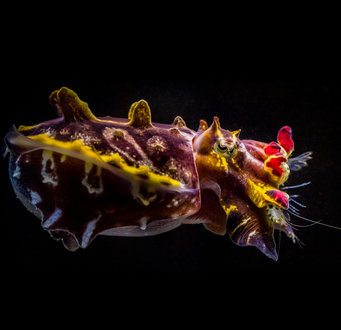Passing clouds in cuttlefish
Max Planck scientists establish tropical cuttlefish Metasepia tullbergi as a model organism to study travelling waves in biological systems

Cuttlefish, squid and octopuses have remarkable control over their skin pigmentation. Cephalopod skin contains elastic pigmented cells called chromatophores. An adult cuttlefish may contain several millions of them. The size of each chromatophore can be rapidly and individually altered by neural activation of radial muscles. If those muscles relax, their chromatophore shrinks. If they contract, the chromatophore grows larger. One form of cephalopod pigmentation pattern is the passing cloud – a dark band that travels across the body of the animal. It can be superimposed on various static body patterns and textures. The passing cloud results from the coordinated activation of chromatophore arrays to generate one, or as in the present case, several simultaneous traveling waves of pigmentation.
The tropical cuttlefish Metasepia tullbergi proves to be a suitable model organism to investigate the possible neural mechanisms underlying these passing clouds. Using high-speed video cameras with 50 or 100 frames per second, the scientists from the Max Planck Institute for Brain Research observed that the mantle of Metasepia contains four regions of wave travel on each half of the body. Each region supports a different propagation direction with the waves remaining within the boundaries of a given region. The animal then uses different combinations of such regions of wave travel to produce different displays.

The waves’ travelling speed can vary up to six-fold, but it is the same in all regions at a given time. The wavelength of each wave corresponds roughly to its length of travel, so that usually only one band is visible in each region at a time. Those regions that are active simultaneously are also perfectly synchronized, meaning that the arrival times of two bands in their respective region match. In addition, the researchers observed that a travelling wave can even disappear and reappear in a different position, a phenomenon they call ‘blink’. It is a transient and local decrease in the intensity of the band, revealing on-going but invisible band propagation.
The results indicate that the passing clouds are not generated by the motoneurons in the mantle of the animal. Instead, neurons upstream of the chromatophore motoneurons are likely to form wave-pattern-generators. “In principle, three different types of neuronal circuits could be responsible for the periodic traveling waves in Metasepia tullbergi. Based on our results we can exclude one of these types”, explains Gilles Laurent, Director of the Department of Neural Systems and Coding. The behavioural studies alone do not allow distinguishing between the two types of circuits. If future experiments, however, lend support to one type over the other, the present findings will help to specify the connectivity and biophysical properties of the circuit.
HR













